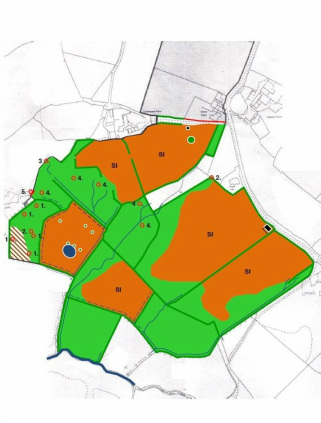Habitats and PlantsECOLOGICAL IMPACT ASSESSMENT (ECIA)Ecologic regularly prepares Ecological Impact Assessment (EcIA), Preliminary Ecological Appraisals (previously known as Extended Phase 1 Habitat Survey) and Ecology Chapters as part of Environmental Impact Assessments (EIA) for clients in Dorset, Devon, Cornwall, Somerset and throughout the UK.
Environmental Impact Assessment (EIA) is required for developments that meet the criteria set out in the European Union Directives 97/11/EC & 85/337/EEC. The EIA includes an Ecology Chapter. Those smaller developments that do not require a formal EIA, frequently require an Ecological Impact Assessment or Preliminary Ecological Appraisal. Ecologic are Preliminary Ecological Appraisal specialists and offer a 5 working day fast track service contact us to arrange this service. The Preliminary Ecological Appraisal known previously as an Extended Phase 1 Habitat Survey includes a desk study obtained from the Local Records Centre which details the protected and notable species, notified sites and priority habitats which allows us to understand a clearer picture of the wildlife interest of an area. The desk study is then supplemented with a field survey which comprises of a walkover assessment of the site using Phase 1 Habitat Survey methodology (JNCC, 1993 as amended by IEA, 1995). This is a standard technique for classifying and mapping British habitats. All areas within the site are surveyed and assessed for indicators of ecological value, including the presence of, or field signs for any protected or rare habitats and species. The results of the desk study and the field survey are then combined in a report that aims to establish baseline conditions and determine the importance of ecological features present (or could be) within the specified area; to establish any requirements for detailed/ further surveys; to identify key constraints to the project and make recommendations for design options to avoid significant effects on important ecological features/resources at an early stage; to identify the mitigation measures as far as possible, including those that may/are required, and to identify any enhancement opportunities If any protected or notable species are identified or potentially present, further species specific survey work may be required. Some surveys, such as for dormice and reptiles, require several repeat survey visits following placement of artificial refugia at the site. Some surveys are also seasonally constrained, depending on the ecology and activity of the species concerned. It is therefore very important that you contact us at an early stage in any development. |
PRELIMINARY ECOLOGICAL APPRAISALS (PEA)Smaller developments that do not require a formal Ecological Impact Assessment (EcIA), frequently require a Preliminary Ecological Appraisal (see below) or a Phase 1 Habitat Survey (see bottom of page).
Ecologic are Preliminary Ecological Appraisal specialists and offer a 5 working day fast track service contact us to arrange this service. The Preliminary Ecological Appraisal known previously as an Extended Phase 1 Habitat Survey includes a desk study obtained from the Local Records Centre which details the protected and notable species, notified sites and priority habitats which allows us to understand a clearer picture of the wildlife interest of an area. The desk study is then supplemented by a field survey which comprises of a walkover assessment of the site using Phase 1 Habitat Survey methodology [see below] (JNCC, 1993 as amended by IEA, 1995). This is a standard technique for classifying and mapping British habitats. All areas within the site are surveyed and assessed for indicators of ecological value, including the presence of, or field signs for any protected or rare habitats and species. The results of the desk study and the field survey are then combined in a report that aims to establish baseline conditions and determine the importance of ecological features present (or could be) within the specified area; to establish any requirements for detailed/ further surveys; to identify key constraints to the project and make recommendations for design options to avoid significant effects on important ecological features/resources at an early stage; to identify the mitigation measures as far as possible, including those that may/are required, and to identify any enhancement opportunities If any protected or notable species are identified or potentially present, further species specific survey work may be required. Some surveys, such as for dormice and reptiles, require several repeat survey visits following placement of artificial refugia at the site. Some surveys are also seasonally constrained, depending on the ecology and activity of the species concerned. It is therefore very important that you contact us at an early stage in any development. |
PHASE 1 HABITAT SURVEYThe main purpose of a Phase 1 Habitat Survey is to record the vegetation and wildlife habitat over a specific area in order to assess the likely impacts of developments. It acts as a precursor to proposed projects involving areas of previously undeveloped land and developments.
The survey is a relatively quick assessment technique includes evaluation of the ecological features present, as well as scoping for notable species or habitats, identification of potential restraints to proposed development schemes and recommendations where further surveys and mitigation are required. More specifically it records semi-natural vegetation and other wildlife habitats. Each habitat type/feature is defined by way of a brief description and is allocated a specific name, an alpha-numeric code, and unique mapping colour. The system has been widely used and continues to act as the standard ‘phase 1’ technique for habitat survey across the UK. In addition it identifies any requirement for more detailed habitat surveys including National Vegetation Classification (NVC) and Hedgerow Assessments - both of which Ecologic provide. Please contact us for more information, advice or would like to arrange a survey. |



